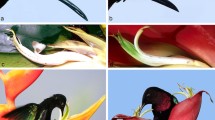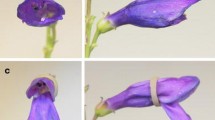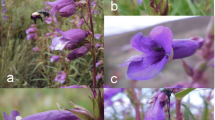Abstract
Many nectar-feeding animals use cues (floral signals) to locate, identify, and discriminate between floral resources. Whether competing pollinators can use cues to partition resources, however, has received little attention despite examples of pollinators differing in resource use. We examined whether sexes of the purple-throated carib hummingbird, Anthracothorax jugularis, partition artificial nectar sources (feeders) by color (red or yellow) or position (left or right), and whether such partitioning changes in response to changes in nectar reward. At equal nectar concentrations, sexes partitioned resources by color, but when one of the colors was reduced in quality, dominant males visited the more rewarding color, although they did not completely displace subordinate females. The position of the feeder had no effect on resource partitioning, and in the absence of color cues, male and female hummingbirds did not partition feeders. Our results differ from earlier studies where hummingbirds responded more to position than to color. We suggest that this difference may result from defense of patches as opposed to choice of individual food items as well as from differences between temperate and tropical hummingbird-plant communities in floral colors. Hummingbird-pollinated plants in many temperate communities converge on red flowers, which may eliminate color as a cue for resource partitioning, whereas the availability of plant species differing in floral color and pattern may provide tropical nectarivores with cues for resource subdivision.
Significance statement
Our results have major implications for the evolution of species diversity. Because plants and pollinators may reciprocally affect each other’s evolution, partitioning of floral resources by color may not only affect traits of pollinators but also may maintain and drive the diversification of floral colors and other floral traits.



Similar content being viewed by others
References
Carlson JE, Holsinger KE (2010) Natural selection on inflorescence color polymorphisms in wild Protea populations: the role of pollinators, seed predators, and intertrait correlations. Am J Bot 97:934–944
Chittka L, Thomson JD (2001) Cognitive ecology of pollination: animal behavior and floral evolution. Cambridge University Press, Cambridge
Copenhaver C, Ewald PW (1980) Cost of territory establishment in hummingbirds. Oecologia 46:155–160
Cotton PA (1998) Temporal partitioning of a floral resource by territorial hummingbirds. Ibis 140:647–653
Darwin C (1859) On the origin of species by means of natural selection. John Murray, London
Dziedzioch C, Stevens A-D, Gottsberger G (2003) The hummingbird plant community of a tropical montane rain forest in southern Ecuador. Plant Biol 5:331–337
Eckhart VM, Rushing NS, Hart GM, Hansen JD (2006) Frequency-dependent pollinator foraging in polymorphic Clarkia xantiana ssp. xantiana populations: implications for flower colour evolution and pollinator interactions. Oikos 112:412–421
Gegear RJ, Burns R, Swoboda-Bhattarai KA (2017) “Hummingbird” floral traits interact synergistically to discourage visitation by bumble bee foragers. Ecology 98:489–499
Gill FB (1988) Trapline foraging by hermit hummingbirds: competition for an undefended, renewable resource. Ecology 69:1933–1942
Goldsmith TH, Goldsmith KM (1979) Discrimination of colors by the black-chinned hummingbird, Archilochus alexandri. J Comp Physiol 130:209–220
González-Gómez PL, Vásquez RA (2006) A field study of spatial memory in green-backed firecrown hummingbirds (Sephanoides sephanoides). Ethology 112:790–795
Gowda V, Kress WJ (2013) A geographic mosaic of plant-pollinator interactions in the Eastern Caribbean Islands. Biotropica 45:224–235
Grant KA (1966) A hypothesis concerning the prevalence of red coloration in California hummingbird flowers. Am Nat 100:85–97
Healy SD, Hurly TA (2001) Foraging and spatial learning in hummingbirds. In: Chittka L, Thomson JD (eds) Cognitive ecology of pollination: animal behaviour and floral evolution. Cambridge University Press, Cambridge, pp 127–147
Henderson J, Hurly TA, Healy SD (2001) Rufous hummingbirds’ memory for flower location. Anim Behav 61:981–986
Hurly TA, Healy SD (1996) Memory for flowers in rufous hummingbirds: location or local visual cues? Anim Behav 51:1149–1157
Hurly TA, Franz S, Healy SD (2010) Do rufous hummingbirds (Selasphorus rufus) use visual beacons? Anim Cogn 13:377–383
Irwin RE, Strauss SY, Storz S, Emerson A, Guibert G (2003) The role of herbivores in the maintenance of a floral color polymorphism in wild radish. Ecology 84:1733–1743
Jones KN, Reithel JS (2001) Pollinator-mediated selection on a flower color polymorphism in experimental populations of Antirrhinum (Scrophulariaceae). Am J Bot 88:447–454
Kodric-Brown A, Brown JH (1978) Influence of economics, interspecific competition, and sexual dimorphism on territoriality of migrant rufous hummingbirds. Ecology 59:285–296
Kodric-Brown A, Brown JH, Byers GS, Gori DF (1984) Organization of a tropical island community of hummingbirds and flowers. Ecology 65:1358–1368
Leonard AS, Dornhaus A, Papaj DR (2012) Why are flower signals so complex? An outline of functional hypotheses. In: Patiny S (ed) Evolution of plant-pollinator relationships. Cambridge University Press, Cambridge, pp 261–282
Lihoreau M, Chittka L, Raine NE (2010) Travel optimization by foraging bumblebees through readjustments of traplines after discovery of new feeding locations. Am Nat 176:744–757
Medel R, Botto-Mehan C, Arroyo-Kalin M (2003) Pollinator-mediated selection on the nectar guide phenotype in the Andean monkey flower, Mimulus luteus. Ecology 84:1721–1732
Nagamitsu T, Inoue T (1997) Aggressive foraging of social bees as a mechanism of floral resource partitioning in an Asian tropical rainforest. Oecologia 110:432–439
Narum SR (2005) Beyond Bonferroni: less conservative analyses for conservation genetics. Conserv Genet 7:783–787
O’Brien RG, Kaiser MG (1985) MANOVA method for analyzing repeated measures designs: an extensive primer. Psychol Bull 97:316–333
Ohashi K, Leslie A, Thomson JD (2008) Trapline foraging by bumble bees: V. Effects of experience and priority on competitive performance. Behav Ecol 19:936–948
Ornelas JF, Lara C (2014) Differential response to colour tasks on resident and migratory hummingbirds: a field test. Ethol Ecol Evol 27:357–378
Paton DC, Carpenter FL (1984) Peripheral foraging by territorial rufous hummingbirds: defense by foraging. Ecology 65:1805–1819
Pérez G, Lara C, Viccon-Pale J, Signoret-Poillon M (2011) Memory for location and visual cues in white-earred hummingbirds Hylocharis leucotis. Curr Zool 57:468–476
Pfennig DW, Pfennig KS (2012) Evolution’s wedge: competition and the origins of diversity. University of California Press, Berkeley
Pimm SL, Pimm JW (1982) Resource use, competition, and resource availability in Hawaiian honeycreepers. Ecology 63:1468–1480
Pritchard DJ, Scott RD, Healy SD, Hurly AT (2016) Wild rufous hummingbirds use local landmarks to return to rewarded locations. Behav Process 122:59–66
Raffaele H, Wiley J, Garrido O, Keith A, Raffaele J (1998) A guide to the birds of the West Indies. Princeton University Press, Princeton
Raguso RA (2004) Flowers as sensory billboards: towards an integrated understanding of floral advertisement. Curr Opin Plant Biol 7:443–440
Ranta E, Lundberg H (1980) Resource partitioning in bumblebees: the significance of differences in proboscis length. Oikos 35:298–302
Rodríguez-Gironés MA, Santamaría L (2004) Why are so many bird flowers red? PLoS Biol 2:e350
Rodríguez-Gironés MA, Santamaría L (2006) Models of optimal foraging and resource partitioning: deep corollas for long tongues. Behav Ecol 17:905–910
Samuels M, Hurly TA, Healy SD (2014) Colour cues facilitate learning flower refill schedules in wild hummingbirds. Behav Process 109:157–163
Sandlin EA (2000a) Cue use affects resource subdivision among three coexisting hummingbird species. Behav Ecol 11:550–559
Sandlin EA (2000b) Foraging information affects the nature of competitive interactions. Oikos 91:18–28
Schluter D (2000) The ecology of adaptive radiation. Oxford University Press, Oxford
Snow DW, Snow BK (1980) Relationships between hummingbirds and flowers in the Andes of Columbia. Bull Brit Mus Nat Hist (Zool) 38:105–139
Stamps JA, Krishnan VV (1999) A learning-based model of territory establishment. Q Rev Biol 74:291–318
Stiles FG (1976) Taste preferences, color preferences, and flower choice in hummingbirds. Condor 78:10–26
Tello-Ramos MC, Hurly TA, Healy SD (2014) Female hummingbirds do not relocate rewards using color cues. Anim Behav 93:129–133
Temeles EJ, Kress WJ (2003) Adaptation in a plant-hummingbird association. Science 300:630–633
Temeles EJ, Kress WJ (2010) Mate choice and mate competition by a tropical hummingbird at a floral resource. Proc R Soc Lond B 277:1607–1613
Temeles EJ, Pan IL, Brennan JL, Horwitt JN (2000) Evidence for ecological causation of sexual dimorphism in a hummingbird. Science 289:441–443
Temeles EJ, Goldman RS, Kudla AU (2005) Foraging and territory economics of sexually dimorphic purple-throated caribs (Eulampis jugularis) on three Heliconia morphs. Auk 122:187–204
Temeles EJ, Shaw KC, Kudla AU, Sander SE (2006) Traplining by purple-throated carib hummingbirds: behavioral responses to competition and nectar availability. Behav Ecol Sociobiol 61:163–172
Temeles EJ, Koulouris CR, Sander SE, Kress WJ (2009) Effect of flower shape and size on foraging performance and trade-offs in a tropical hummingbird. Ecology 90:1147–1161
Temeles EJ, Rah YJ, Andicoechea J, Byanova KL, Giller GSJ, Stolk SB, Kress WJ (2013) Pollinator-mediated selection in a specialized hummingbird-Heliconia system in the Eastern Caribbean. J Evol Biol 26:347–356
Temeles EJ, Newman JT, Newman JH, Cho SY, Mazzotta AR, Kress WJ (2016) Pollinator competition as a driver of floral divergence: an experimental test. PLoS One 11:e0146431
Tobias J (1997) Asymmetric territorial contests in the European robin: the role of settlement costs. Anim Behav 54:9–21
Whitfield M, Köhler A, Nicolson SW (2014) Sunbirds increase foraging success by using color as a cue for nectar quality. Behav Ecol 25:328–334
Wolf LL (1975) Territoriality in the purple-throated carib. Auk 92:511–522
Wolf LL, Stiles FG, Hainsworth FR (1976) Ecological organization of a tropical, highland hummingbird community. J Anim Ecol 45:349–379
Acknowledgements
We thank J. Andre, S. Durand, and M. Burton of the Forestry Service of the Commonwealth of Dominica for assistance and support, S. and A. Peyner-Loehner for accommodations and hospitality, and three anonymous reviewers, E. Fernandez-Juricic, T. C. M. Bakker, and N. J. Horton, for comments and consultation. Our research was supported by Amherst College and NSF grant DEB 1353783.
Author information
Authors and Affiliations
Corresponding author
Ethics declarations
Funding
Our research was supported by Amherst College and NSF grant DEB 1353783.
Conflicts of interest
Ethan Temeles has received research grants from NSF and Amherst College. Alexandra Mazzotta received support from Amherst College. April Williamson declares that she has no conflict of interest.
Ethical approval
This research was approved by Jacqueline Andre and Stephen Durand of the Forestry, Wildlife, and Parks Division of the Ministry of Agriculture and Forestry of the Commonwealth of Dominica. Stefan and Annette Peyner-Loehner gave us permission to work on their property, the Tamarind Tree Hotel, Salisbury, Dominica, West Indies.
Data availability
All data generated or analyzed during this study are included in this published article [and its supplementary information files].
Additional information
Communicated by E. Fernandez-Juricic
Electronic supplementary material
ESM 1
(XLS 35 kb)
Rights and permissions
About this article
Cite this article
Temeles, E.J., Mazzotta, A.R. & Williamson, A. Resource partitioning by color in a tropical hummingbird. Behav Ecol Sociobiol 71, 129 (2017). https://doi.org/10.1007/s00265-017-2358-5
Received:
Revised:
Accepted:
Published:
DOI: https://doi.org/10.1007/s00265-017-2358-5




